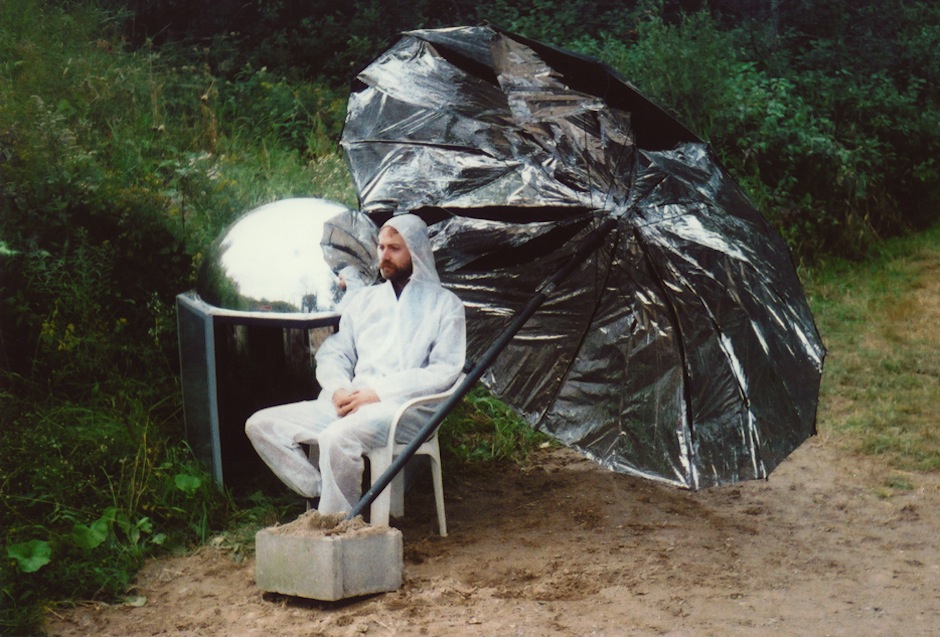 Single LifeThe exhilarating highs. The devastating lows. The middling middles.
Single LifeThe exhilarating highs. The devastating lows. The middling middles.

Tech-Know
Technology and science news, and why you can use it. Nothing boring.
A non-definitive and by no means comprehensive guide to the future. Relevant inclusions only. Brush up your general knowledge in the rapidly evolving geek realms of business, science, technology, software, computing, entertainment, design, and gadgetry. If you're feeling out of your depth because this is about technology and not music, you might enjoy that every news bit below comes preceded by a song lyric.
[Image: Thomas Van Der Staag]
Regrets? I’ve have a few.
Gmail Introduces Undo Send
What’s Happening: Ever accidentally hit ‘send’ before you were ready? And then madly Googled ‘how to unsend email’? The Undo feature is heading out of the Labs and will be an option for all Gmail users, giving you between 5 - 30 extra seconds to change your mind. Navigate to your Settings pane in the menu directly below your profile photo and you’ll be given the option to ‘Enable Undo Send’, along with a drop-down that lets you customize the cancellation period for the feature.
What it means for us: You can go back and re-attach that attachment you forgot to attach, and you won’t look like a loser sending a half written email, and you can avoid those unprofessional typos with a second glance. Unfortunately, a drunken late night rant-mail to your ex will have past the point of no unsend by the time you wake up the next day.

I'll be watching you.
Apple Watches & Traffic Fines
What’s Happening: The Canadian guy who achieved instant notoriety by being the world's first person to get a traffic fine for using his Apple Watch whilst driving is appealing his case, arguing that he was using the watch to change a song playing, and that his hands remained on the steering wheel (and therefore was not a 'handheld device' which is what the legislation rules against). It's not the first time a wearable gadget has landed a driver in trouble. In October 2013, a 44 year-old lady was fined for wearing a Google Glass headset while driving (legally, you can't have a monitor - like a TV or whatever - any further forward than the backseat of the drivers seat). The court ditched the case however, because they couldn't prove the Google Glass headset was turned on.
What it means for us: The Canadian case will likely set a precedent. Additionally, the UK has also just put in place increased penalties for technology-happy drivers, with Brits running the risk of a 200 pound fine if they get caught using their phone (calling, texting, changing a song) at the wheel, with Apple Watches included. According to an Australian patrol officer, we're 100% at risk of getting tickets for using Apple Watches under distracted driving laws: “Australian drivers might not be booked under mobile phone laws but they can be booked for not paying due care and attention, or booked under driver distraction laws.” So, unless you fancy forking over $300 and losing a buttload of demerits, you better watch yourself!

Everything in its right place.
Drive Attachments & Google Calendar
What’s happening: Hot fire from the Google dev desk: if you have an iPhone (Android already did this a few months ago), you can now grab stuff from your Drive and attach it directly to Google Calendar events - documents, PDFs, work presentations – and choose who can share and edit them on your Calendar. There’s also interactive notifications that add an option to email guests and to open a saved location in Maps from the lock screen.
What it means for us: You can do this from you computer already, but it’s not the handiest if you’re on the road – this way, you don’t have to get flustered before a meeting trying to bring things up on different screens and devices – just click your calendar meeting and there’s a handy document your organised self attached earlier, outlining your meeting goals. Way more efficient than agendas being emailed. Of course, this is only going to be useful to you if you’re keeping your Drive updated regularly…
On the (wireless) street where you live.
Google’s Intersection project
What’s happening: Google has a new urban improvement initiative start-up called Sidewalk Labs, and their goal is to improve technology in cities. Sidewalk and a bunch of investors have gotten behind the companies (Control and Titan) who run LinkNYC, an initiative that offers free, public WiFi across New York via the conversion of old pay phones into wireless hubs –they plan to bring LinkNYC’s internet-for-all technology to cities worldwide with a project called Intersection, using different pieces of urban infrastructure, from pay phones to bus stops. Dan Doctoroff, who heads up Sidewalk Labs, and was once the deputy mayor of New York City, said that after the positive way local governments in NYC responded to LinkNYC, the largest public Wi-Fi project of its kind, the transition to other countries won’t take long. "That’s one of the beauties of doing something in New York first," he says. "What happens here is seen everywhere."
What it means for us: One day, you’ll walk down the street, and you’ll get fast, wireless data thanks to hubs everywhere. Altruistically, for the millions of people who don’t have broadband internet access, particularly in rural areas, this partnership of public and private will lead to greater connectivity. Mobile phone carriers are obviously delighted at the prospect.
Get me to church on time.
Churchix
What’s happening: God’s always watching over us. Only now, he’s doing it via CCTV and facial recognition software. An Israeli software company called Face-six invented a facial recognition system that scans CCTV feeds and matches people to a pre-existing database of faces, and its apparently very accurate. Now, more than twenty churches around the world have started using a version of Face-six called Church-six, which shows which members of the flock are showing up for the Sunday service, via the church’s CCTV monitors.
What it means for us: If you’re a Catholic, even more guilt feels for wagging the Sunday sermon in place of the Sunday sesh. If you don’t go to church ever, fair to say this will probably have no effect on you. Eternal damnation for never going to church, on the other hand, may be an issue.

A whole new world.
Instagram Real-Time Search
What’s happening? Instagram’s decided it’s going to be a window into not only your friends’ (and a few strangers’) lives, but the window into…every place you can think of. Instagram’s rolled out a real time search feature, included are images, people, places and tags. Of the most interest here is Places. Is Iceland trending as a holiday destination on Instagram? Jump on Instagram and see the best photos and videos being taken in Iceland right now. Not at Coachella but wish you were? Watch Coachella curated by Instagram. Or catch see real time photos of important and trending topics chosen by Instagram’s team. Twitter and Periscope are currently the definitive real-time news platform and real-time media video platform respectively in this area, and you’ll be familiar with this real-time ‘insert you in a place’ feature if you have Snapchat – they’re making progress with it via their ‘Discovery’ Snap Stories. Now, it’s Instagram’s turn to tap into places as a rich source of visual content. Read Instagram’s announcement here.
What it means for us? More holiday and music gig envy? With 300 million+ Instagrammers in every corner of the world, wherever events unfold someone on Instagram is probably there to capture it, hashtag it, and make you wish you were there.

Green Machines.
Harnessing the Power of Plants
What’s happening? Over in the Netherlands, a company called Plant-e has worked out how to use plants to generate electricity, using principles of photosynthesis. Back in November they launched their first big test, Starry Sky, where they were able to power more than 300 LED streetlights (without stopping the plants from growing). Whilst LEDs are very energy efficient, Plant-E’s planning to scale up its technology. The basic gist is that plants undergo photosynthesis – which is turning solar power into sugars – and they produce more sugars than they need, so the excess is cast out through their roots into the surrounding soil and broken down into protons and electrons. Plant-e’s system uses electrodes in the soil to await the breakdown of this plant waste and conduct electricity. Read in more detail about the science behind it here.
What it means for us? If Plant-E nail it, we’ll be able to produce electricity from living plants at practically every site where plants can grow – so you could build a house around a tree and power that whole house from the tree. Not just residential power, but No more coal plants, no hydroelectric dams ruining the environment…just plant power. It could also mean that, in poor areas of the world where plant life is abundant (such as in rice paddies or near wetlands) this could be a great way to bring electricity to people who have never had it (nearly 25 percent of the world’s population), although this depends on them finding a cost-effective way to achieve that.

Do you see what I see?
HoloLens - Virtual Reality Goggles
What’s happening? News from the immersive interactive technologies front: earlier this year Microsoft stepped into augmented reality, revealing HoloLens a headset featuring two transparent HD holographic lenses, that overlay holographic images over the real world – so it looks like digital stuff is part of your real world. It’s a step up from Facebook’s Oculus Rift and Sony’s Project Morpheus, which construct the digital world for you – HoloLens is equipped with sensors that detect the real world and the user’s gestures while not needing to connect to a phone or computer. The demo video showed architects walking through building renders, and someone playing Minecraft on a tabletop. Microsoft’s 'father of Kinect', Alex Kipman, said that the holograms work by tricking your brain into seeing light as matter. “Ultimately, you know, you perceive the world because of light,” Kipman explains. “If I could magically turn the debugger on, we’d see photons bouncing throughout this world. Eventually they hit the back of your eyes, and through that, you reason about what the world is. You essentially hallucinate the world, or you see what your mind wants you to see.” At Microsoft’s recent developer conference in April (Build), Microsoft showed off Hololens with a new experience for attendees where you could manipulate 'origami' – take a look below. Also recently at the games conference E3 Microsoft showed off a version of Minecraft built for the device and wowed a fair few people.
What it means for us? HoloLens isn’t just an advance that will lead to more fun for gamers, but will be extended to areas like science, education and the arts - holograms will become practical tools of daily life – a chance to share your ideas, and show and tell from multiple perspectives, or learn from them. The only downside so far is a narrow field of view. But even as a flawed / still-to-be-improved product, it’s already captured our collective imagination.
Together in electric dreams.
Life-saving lungs and digital immortality
What’s happening? 60 year-old Martine Rothblatt has pushed the boundaries of possibility her entire career – she started out as a telecommunications lawyer, creating GeoStar and satellitle radio service Sirius Radio. Then, in the 90s, in desperate hope of developing a drug to save her daughter from an often fatal, rare lung disease, that Rothblatt sold some of her shares in Sirius and founded United Therapeutics, a genetic engineering research company. She did eventually develop the drug, saving her daughter and many others, and when the pill form of the drug went public last year, the stock instantly doubled, and banked 38 million last year, making Rothblatt America’s highest-paid female executive. She also recently wrote a book Virtually Human: The Promise – and Peril – of Digital Immortality about the ways in which technology can help extend human life - perhaps indefinitely. She’s also working to create a limitless supply of transplant organs from genetically altered pig organs, and looking into creating mind clones – so human life can exist beyond natural death. As wel; as this, she’s developed a human-like container system to keep transplant lungs in pristine and working condition until they reach the recipient (thousands of lungs don’t last long enough to make transplants successful). She’s already saved 400 lives.
What it means for us? For those who need lung transplants, increased chances of survival. Plus organ donors knowing their lungs will get use. Also, one day we might be able to hang out with robot, cyber conscious versions of real-life people who have died – mind clones with a real person’s mannerisms, personality, recollections, feelings, beliefs, attitudes and values. Watch a riveting TED Talk with Martine below. The future is very cool.
 Single LifeThe exhilarating highs. The devastating lows. The middling middles.
Single LifeThe exhilarating highs. The devastating lows. The middling middles.
 No Money Weekend June 26Your essential nation-wide cheapskates event guide.
No Money Weekend June 26Your essential nation-wide cheapskates event guide.